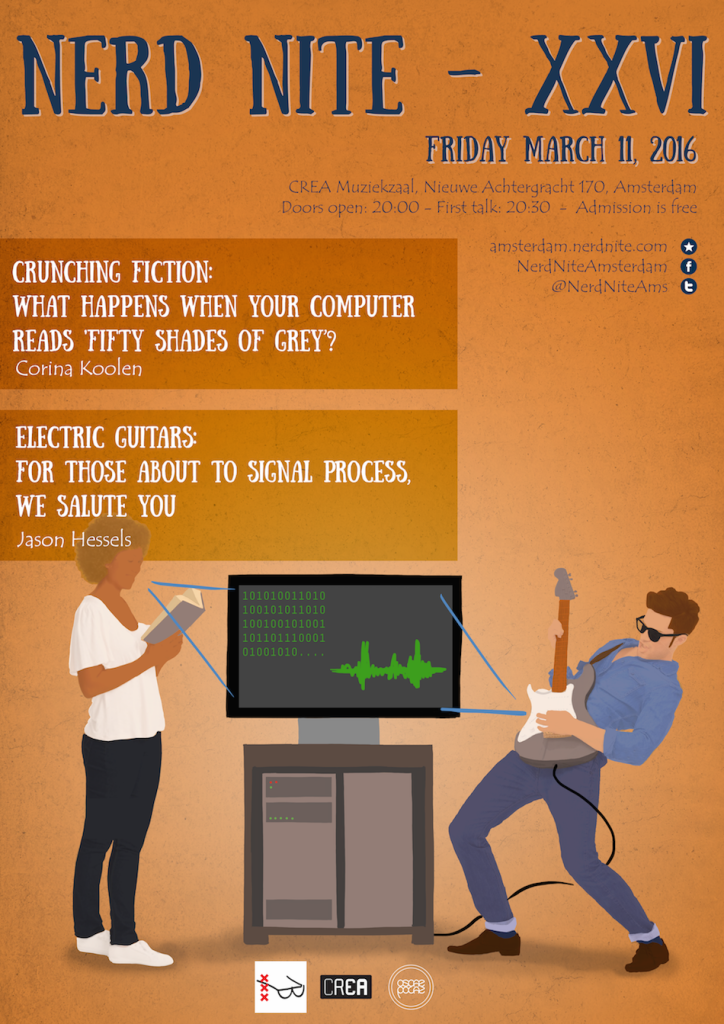Nerd Nite XXVI: Digital artistry
Let’s get digital at Nerd Nite on Friday March 11th! What do King Lear and Fifty Shades of Grey have in common? Both can be crunched by a computer and analyzed for literary qualities (and that’s probably about where their similarities end)! Speaker Corina Koolen will demonstrate the results of letting computer algorithms tackle creative fiction, and why Eat, Pray, Love isn’t so bad from an analytical perspective. After that, Jason Hessels takes to the stage to show us the nerdy side of electric guitars, complete with live demo! We’ll learn how signal processing makes rock concerts possible, and how electric guitars relate to astronomy. Sandwiched between the talks is our once-a-year Pictionerdy pubquiz. Be there and be square!
Also don’t forget to sign up for Nerd Nite Speed Dating, on March 11 from 18:30-20:00. It’s like in-person Tinder for nerds!
DETAILS:
Friday 11 March
Doors at 20:00
First talk at 20:30
at CREA Muziekzaal
Nieuwe Achtergracht 170
1018 WV Amsterdam
Crunching Fiction: What happens when you let your computer read Fifty Shades of Grey
by Corina Koolen

What can we say about best-sellers when we feed them to a computer? Why use computers on fiction in the first place? In this talk, Corina Koolen will show you the wonders of computer-based analyses of creative text. You’ll find out which Dutch prize-winning literary author writes like Sophie Kinsella, why there is no reason to dislike Eat, Pray, Love so much and how a computer can tell that E.L. James’s Fifty Shades of Grey is less literary than Emma Donoghue’s Room.
Bio: Corina Koolen is a PhD candidate in Digital Humanities at the University of Amsterdam. In practice this means she pulls recent Dutch novels through a computer and hits them with a virtual hammer. When she’s not working, she knits, reads, dances, or watches TV series, though not all at the same time.
The Physics of the Electric Guitar: For those about to signal process, we salute you
by Jason Hessels

Rock ‘n Roll is cool… at least it used to be when I was a kid. What’s the coolest part of Rock ‘n Roll? Well, obviously the electric guitar; no one wants to get stuck playing bass, after all. But what’s even cooler than the electric guitar? The answer: signal processing, waveforms, power spectra, Fourier decomposition. In this talk, I will give a flavor for how signal processing is an integral part of shaping the sound of the electric guitar and, by extension, has been pivotal in the history of Rock ‘n Roll. I’ll also make some (questionable) links to my own research on neutron stars (the bad boys of stellar astrophysics).
Bio: Jason Hessels is an Associate Professor (Universitair Hoofddocent) at the University of Amsterdam’s Anton Pannekoek Institute for Astronomy and ASTRON, the Netherlands Institute for Radio Astronomy. Jason is a radio astronomer and uses the world’s largest radio telescopes to study pulsars – i.e. neutron stars that produce regular flashes of radio light. Using pulsar signals, he aims to test theories of gravity, dense matter physics, and astrophysical accretion.
